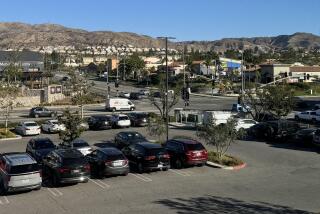Home Court Disadvantage : Local Youths Play Basketball in the Heat on Cracked Asphalt While Out-of-Towners With Permits Use Well-Kept Area Gyms
- Share via
Not many basketballs bounced off the asphalt courts in East Los Angeles on a recent Sunday. Just a couple of boys shot a few hoops at El Sereno’s outdoor recreational center, but with temperatures in the 90s, the court was as hot as a pancake griddle.
They might have sought relief at the better-maintained gyms of their local schools, but those courts have been filled this summer by groups from as far away as Thousand Oaks.
“It is very discouraging to see the local kids playing on the asphalt and outsiders playing in the gym,” said Otis Yette, athletic director at Garfield High. Instead of playing inside at nearby Garfield on weekends, he said, youngsters play at Belvedere Park, north of the school on the other side of the Pomona Freeway.
Adult and youth groups from outside the area use school gyms through a permit process run by the Los Angeles Unified School District. While fees paid by the adult groups help cover gym maintenance, some say the permit process is unfair to Eastside youths. Youths looking for a pickup game must play on outdoor courts in the heat, compete for the few indoor courts at recreational centers or look to the streets to fill their time.
“The kids (today) will slip into these little gangs and they turn around and destroy the community,” said Rourke Huff, Lincoln High’s basketball and track coach. “When you don’t have anything to do you get in trouble.” Huff, 41, recalled that there were plenty of tournaments and athletic programs to join when he was growing up in the late 1960s in Lincoln Heights. “If you’ve got a gym for kids to play basketball, they’ll stay out of trouble and at least parents know where their kids are.”
Adriane Alvarez, a 1992 Wilson High graduate and now the school’s head junior varsity and assistant varsity basketball coach, grew up in City Terrace with friends who showed an interest in basketball but turned to gangs. As youngsters, he said, they played basketball on outside courts that were covered by a dome.
“After a while they didn’t want to play anymore because they saw others who had inside gyms. I know when I was growing up I wanted to play on a nice court.
“It is safer to play inside because if you take a fall on the outside courts you can scrape a knee against the gravel. The surface is uneven,” Alvarez said. “If you fall inside, the worst that can happen is you’ll slide across the floor.”
“Our outside facilities are pathetic,” agreed Huff. “There are busted wine and beer bottles all over and there are cracks in the pavement from the earthquake.”
*
Four years ago, an open-play policy coexisted with the permit policy, said Eddie Barreras, an employee of Youth Services, which operated open play, allowing the facilities to remain open after school, evenings and Saturday afternoons. The program, coordinated through the school district’s permit office, paid for a gym supervisor but was scrapped during budget cuts.
Now the gyms are only available through the permit process, which doesn’t allow for informal, or pickup games, nor does it allow the freedom to play beyond an allotted time, Alvarez said.
Organized youth groups are not charged gym rental to play, but a minimum of 12 individuals is required to apply for a permit. Small groups must play a minimum of two hours to make it worthwhile for someone to supervise play, while larger associations and leagues can play six hours or up to an entire day, for instance when tournaments are held. The gyms can be rented until 9:30 p.m. Monday through Saturday and from noon to 5 p.m. Sunday. School athletic events have priority.
Adult groups, which must have at least 12 players as well, pay almost $19 an hour for a large gym, about $17.50 an hour for a small gym and a onetime processing fee of about $21, said Mary Lou Del Campo, principal clerk at the school district’s Civic Center permit office. Applications must be submitted at least 1 1/2 months before each four-month rental period.
The permit fees are put in the Board of Education’s general account. Although Del Campo could not disclose the total amount earned, she said the adult groups generate enough money to cover gym maintenance costs but the district loses money by not charging youth groups.
“When they first eliminated open play,” said Barreras, “kids would come up to the gym but there would be a league playing. When they saw they weren’t going to be able to play, they quit coming.”
*
Rounding up enough youths to play regularly and paying for a permit are daunting, some say.
“There were usually only two or three of us playing basketball, so it was not worth it to (get a permit for) a gym,” said Lupe Rodriguez. Rodriguez graduated from Garfield last year and lives across the street from the school.
She and her friends usually play once or twice a week at Belvedere Park or look for some hardwood at Garfield High.
“There were always people in there (in Garfield’s main gym), so you really couldn’t use it,” she said. Instead, Rodriguez said, she and her friends play in the school’s smaller, cramped gym.
“In a way, we did mind that the courts were rented because most of the time those groups weren’t from our school,” she said.
Gardena, Thousand Oaks, San Gabriel, Alhambra--they come from everywhere, Huff said. “I can see why the community is (upset). You can’t use the gym but you pay your taxes,” Huff said.
Mario Cantu, Wilson’s varsity basketball and baseball coach, said that the Mules’ gym is always in demand. The school has hosted events during the last few Watts Summer Games and has an eight-page summer sign-up list, with paying groups like the Hollenbeck police division and the Landau Lawyers League.
Even high school basketball players have difficulty accessing gyms in the summer. Huff’s Lincoln High boys basketball team members practice at Lincoln Park because the school gym cannot accommodate all the school’s athletic teams, including the volleyball team seeking to use the gym.
Every afternoon, Huff shepherds his players to Lincoln Park’s indoor gym, where they are only allowed to practice for 30 to 40 minutes because even that gym is in demand. They once played 10 minutes over their allotted time limit and were put on probation by the park’s recreational center.
Eastside parents often talk of starting athletic leagues, but the organizations seldom materialize, Cantu said. “I don’t know why we haven’t started these programs that we had in the ‘70s and early ‘80s,” he said. “The need is here and the kids are here.”
“We need to prioritize our area,” he said. “It needs to be understood that the people here should have first choice in the use of the facilities.”
The lack of leagues and places to play basketball, Huff said, affects the quality and number of players he recruits for his teams. “If there was a gym the kids would stay, but they are bused out,” he said. “They go to the (San Fernando) Valley where there are better facilities.”
More to Read
Sign up for Essential California
The most important California stories and recommendations in your inbox every morning.
You may occasionally receive promotional content from the Los Angeles Times.










